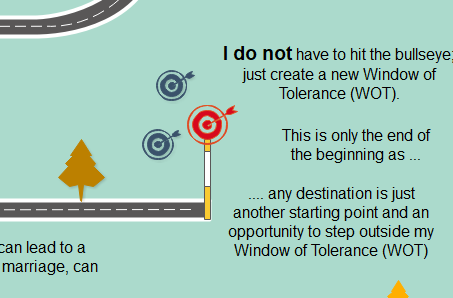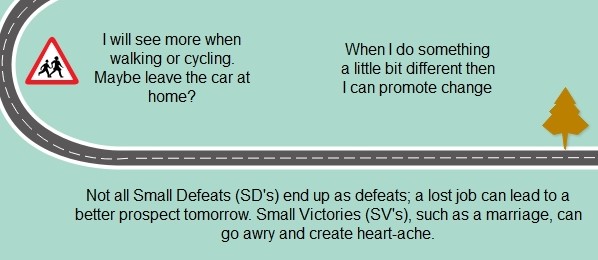On this page, I spell out the Achilles Heel of this website.
I’ve hinted at it, glanced at it and suggested it.
Now I am saying that the ‘scenic route’ is just another map
OK, it’s my map, but it’s still just a map and that is NOT the territory in which you are walking.
Why? Because I cannot know your experience, I can only ask you about it.
Even then, when you answer, I can only learn about your map for viewing your territory! What you and I see, with our eyes, is not what we perceive in our mind. As I say, on the last hyper-linked page is “what we see is NOT what we get“
Despite all this, I am going to inquire further into ‘meaning’ and how it is obtained. That way, I may better understand meanings that help – as long as I know what hinders me as well. I believe the popularity of the Wizard of Oz arises, in part, from its ability to tell a story about ways in which humans learn from adversity.
In my picture, above, I am highlighting some things that can happen to you and I as we work our way along our scenic route. We make meaning with each step we take; with each small victory and small defeat we experience.
Let’s take some of this apart, and see what science, philosophy and poetry has to tell us – where such knowledge can cast some light on small, safe experiments we may want to design.
Some images that might be useful in safe experiments:
Climbing that Mountain
Our literature is full of the challenges imposed on us when humans climb actual mountains or virtual ones. Julie Andrews, for start! Other mountains are just there; climbed – as in the case of Everest – just because ….
Other times, like the Greek, Hercules, we feel impelled to set out on a challenge that seems onerous. In that situation it is easy to be deterred. We might find the determination to go on – one step after another. As you know, I take the view that many small steps will take you further along the mountain track, rather than rush along and knacker yourself and, indeed, ‘stop you in your tracks’!
Not all journeys involve mountains at all; often the mountains we perceive end up as hillocks. Again, this is illustrated well at the end of the Wizard of Oz.
Some safe experiments in hill climbing
Drawing your Road Map slows us down by its very nature. Completing that small experiment, requires us to think about key moments in our lives and make a map to link those events.
That all takes time and – most often – helps us think about what we are doing.
There is often more than one route to the same place. There’s no shame in changing the destination if you can see a scenic route that is easier to follow. This illustration, below, is important.
Destinations can be decided at the beginning of your journey, or along the road.

What about your intentions and your plan of action? What do you want to achieve, and how might you go about it? This alternative is discussed on this page.
Preparation for mountain-climbing will be important. Anticipating obstacles may mean you are better equipped to continue your journey.
The Haunted Wood
This part of the journey was brought to my attention by Richard Holloway.
Richard Holloway was the Bishop of Edinburgh and Primus of the Scottish Episcopal Church. He remains a prolific writer struggling to know his God. One book I want to mention is his: Stories We Tell Ourselves (2020), sub-titled Making Meaning in a Meaningless Universe – published by Canongate.
For those that know me well will be aware that I am atheistic (or polytheistic, I’m never too sure which!), but I share Holloway’s perspective on humans as meaning making creatures. He mentions the work of W H Auden.
Auden’s poem, “September 1, 1939” contains the lines:
All the conventions conspire
W H Auden September 1, 1939
To make this fort assume
The furniture of home;
Lest we should see where we are,
Lost in a haunted wood,
Children afraid of the night
Who have never been happy or good.
This poem, written at the outbreak of World War II, captures the feelings of fear and uncertainty that prevailed at the time. It highlights how the meaning we place on things can eclipse other meanings and can keep us afraid.
Of late, some people will be aware of several Project Fears generated to influence our behaviour. These individuals, often with Government portfolios, are using the ‘nudge’ perspective in an unethical way.
How come are we so susceptible to Project Fears? Because our negative bias pushes us towards controlling our lives and that can end up dropping us into the Haunted Wood, sometimes by parachute!
Auden was aware that the Second World War was dropping a whole generation into a Haunted Wood. Today the woods could become a forest if we let this happen. We are surrounded by so much change in our social, political and employment settings, to name just three.
Some experiments in seeing the wood for the trees
The search for meaning, or finding a sense of purpose in our lives, leads us to develop habitual responses. For instance, on one page I demonstrate how difficult it is to hold two very different pictures in our mind at the same time. One strategy you can follow is to take regular breaks and look at the landscape – and just notice where you ‘really’ are.
Another strategy is to keep your communications under observation. Sometimes it helps to review the labels we use when dealing with other people. Is the wood a forest, or is the wood a beautiful thing seen from afar. Is it a metaphor that needs to be read differently?
A final example I would offer to you is a reasoned approach; the SWOT analysis described near the bottom of the page. This is a useful exercise to help us think, rather than act.
Mode of travel
When my father-in-law was born, horses did much of the fetching-and-carrying; cars were in their infancy, and Bleriot had yet to fly across the English Channel. He thought little of walking many miles in the Welsh valleys in order to do what he wanted.
Today, it is easy to assume that fast travel is our birthright and we should be able to reach our holiday destination NOW. There is a built-in assumption that ‘fast’ is good. This is all very well in the world of ‘holidays’, but adapting, assimilating and accommodating to change involve intricate and multi-layered set of processes.
One thing humans seem to need – to complete those various circles – is time. Sad to say, but Louis Armstrong may have been wrong when he assured us We Have all the Time in the World.
Safe experiments to reconsider modes of travel

This page considers further ways in which we can slow ourselves down; to keep an open mind about your destinations and/or what is ‘important’ to us, now.
We can examine our ways of learning and we can explore the limits of actions. There is an ever-present risk, using this website, of depending on actions – when a time to reflect might be more important.
Elsewhere, I have placed value on CURIOSITY, and that could help. What might be of equal importance is VERSATILITY. There is a time to take a fast car, a time to take a bicycle and time to walk – and to stop, here and there. Take a listen to The Byrds and their rendition of Turn, Turn, Turn to get my point – if you have access to Spotify.
A final comment
It is not easy to break a habit of a lifetime – actions that might create ‘habit releasers,’ and reveal our unknown, unknowns. Breaking open some of our unaware life patterns assumes a degree of insight and self-awareness that can be elusive.
It’s not only our actions that become habit-forming, e.g. smoking, but also our thoughts and feelings. Neural pathways that enable us to feel a certain way may appear to be hard-wired, but our ability to just notice that feeling and to find a word for it, and to express it, depends much on the habits we have adopted from infancy, onward.
So many such patterns are not visible now – out of our reach and knowable. They have the capacity to imprison us; definitely not the full story of who we are.
These human tendencies can be troubling – as I describe in more detail when describing the discounting process. That page was not an easy section to write up so do let me have your own practical examples of how you cast light on your own unknowns:
Some further leads to consider
Exploring what I might do differently https://your-nudge.com/exploring-what-i-might-do-differently/
Approaching Anxieties with safe experiments https://your-nudge.com/approaching-anxieties/
Can I use ‘safe experiments’ to help others? https://your-nudge.com/can-i-use-safe-experiments-to-help-others/
BEYOND EXPERIMENTING: a political commenthttps://your-nudge.com/beyond-experimenting-a-political-comment/
